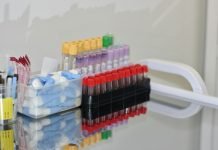
Prostate cancer is the second most common cancer in men in the U.S. and the second leading cause of cancer deaths.
When prostate cancer spreads to other parts of the body, it becomes harder to treat and more dangerous.
One study from Rutgers University found that a specific gene in prostate tumors called the NSD2 gene exists in patients that are at high risk for cancer to spread.
When they turned off the gene in the cancer cells, they effectively reduce the spread of prostate cancer.
The study is published in Nature Communications.
Another study from Washington State University found that prostate cancer cells can hijack the body’s bone maintenance.
This can trigger the spread of bone cancers in 90% of prostate-cancer fatalities.
The researchers discovered a particular enzyme called MAOA can activate a cascade of signals that made it easier for tumor cells to invade and grow in bone.
When they reduced this enzyme in prostate cancer cells, they found a lower prostate cancer bone metastasis.
The study is published in Cancer Cell.
In a third study, researchers from Cornell University found that treating human prostate cancer cells with a drug that targets a protein called PHLPP2 may prevent the cancer cells from spreading to other organs in the body.
They focused on the levels of MYC, an oncogenic protein that can cause many types of cancer that cannot be treated with conventional drugs.
One type of cancer linked to elevated MYC levels in the body is metastatic prostate cancer.
the researchers found that the protein PHLPP2 is also elevated in metastatic prostate cancer cells.
The team found that these cancer cells require PHLPP2 to survive and proliferate. When the Phlpp2 gene was deleted in mice, the prostate cancer cells could be prevented from metastasizing to other organs.
They used a drug that inhibits PHLPP2 and found this could reduce MYC levels and make the cancer cells to stop proliferating and die.
The study is published in the Journal of Cell Biology.
Copyright © 2019 Knowridge Science Report. All rights reserved.




